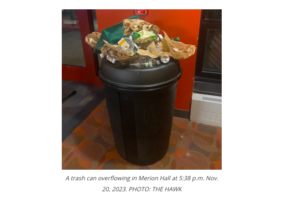Through inclusive design practices, I plan on making my project accessible to all different users.
Points of Exclusion for Primary Deliverables:
Film:
One point of exclusion could be the sound for people who are deaf or hard of hearing. Without closed captions on the interviews themselves, they would not be able to appreciate the video, unless they were reading the lips of those being interviewed. This is not an accessible solution and through design, this can become more accessible.
Website posting:
While this is not a deliverable for my project, the interviews are getting posted to the FJI website. Without ALT text for thumbnails on the embedded videos on the website, people who are blind would not be able to have the alt text read to them through a screen reader.
Accessible Design Solutions:
Closed Captioning:
One accessible design solution for those who are deaf or hard of hearing would be adding closed captioning. Closed captioning allows people with different hearing abilities to understand the content being said. It is unjust to withhold this accessibility feature just because the designer does not necessarily need them. Closed captioning can also be beneficial for people who process information differently, for example, having the ability to read what is being said might help them understand the content more thoroughly. Everyone has different needs, and adding accessibility features can help make a more just design and more ethical world. This interview conducted by GQ speaking to Jacob Elordi has exceptional closed captioning. The captions are accurate, and even describe the feeling of the music. For example, while instrumental music is playing the captions read “[soft sensual music].”

Jacob Elordi sits looking off camera. He is wearing a pink turtleneck sweater and is holding a GQ card. His has short brown hair and is making a half smile. The captions read “It’s a small lizard and it’s covered in thorns, like spikes.”
The Persona Spectrum explains how people with temporary mismatched human interactions would also benefit from closed captions. For example, someone who is not hard of hearing but has an ear infection might be hearing things in a muffled way. Accurate closed captions could help them understand every word. This also goes for bartenders who may want to watch a video on their break at work, but the environment is incredibly loud. Other individuals in noisy environments like a hospital waiting room can also benefit from closed captioning. Additionally, bartenders and certain other professions might suffer from occupational hearing loss due to the loud environments they work in, so closed captions make the video more accessible to them.
Alt Text:
An accessible design solution for people who are visually impaired is alt text. Alt text can allow people with screen readers to understand a photograph or thumbnail easily. While I won’t be posting the videos on the FJI website, I can provide my supervisor with written blurbs of alt text for the thumbnails of the videos. This makes the content more accessible for all different types of users. An example of alt text can be seen in this article in The Hawk, the student newspaper. People with mismatched human interactions could also benefit from alt text. If someone is not sure what a photo is showing, the alt text could explain it to them. Also, as The Persona Spectrum explains, someone who recently had cataract or other eye surgery could benefit from alt text as well.

A black trash can sits on a reddish brown carpet in Merion Hall. There is a a red wall behind it, a window to the right of it and a door to the left of it. The trash can is overflowing with various pieces of garbage piled up over the top of the can. The alt text under the photo reads, “A trash can overflowing in Merion Hall at 5:38 p.m. Nov. 20, 2023. PHOTO: THE HAWK.”
How I Will Distribute My Project:
Within the Program:
My project is based in the Faith Justice Institute, which is an on campus organization with many student employees. There are two different kinds of student employees: Placement Liaisons and Service Scholars. I am a Placement Liaison, and I have a weekly staff meeting with my fellow Placement Liaisons. I will discuss this project in weekly staff meetings with them, and ask them to tell their friends about the project. I also see the Service Scholars in monthly Community Meetings with both student employee groups as well as our supervisors, so I will be getting the word out about this project to about 20-25 student employees at those meetings. I can ask the Service Scholars to promote the project in the Service-Learning classes they lead presentations in weekly. This will spread awareness of the project.
Through Social Media:
Also, my supervisor and I discussed promoting the project on the Faith Justice Institute Instagram, and that is another way the word will spread about the project. My supervisor can also send links to our Community Partners so they can see the videos. I hope through these efforts my project will reach Service-Learning students, Community Partners, and prospective Service-Learning students and new Community Partners. Through the social media publicity as well as discussion within the department and in the service-learning classes, I believe the project will reach people.
Leave a Reply